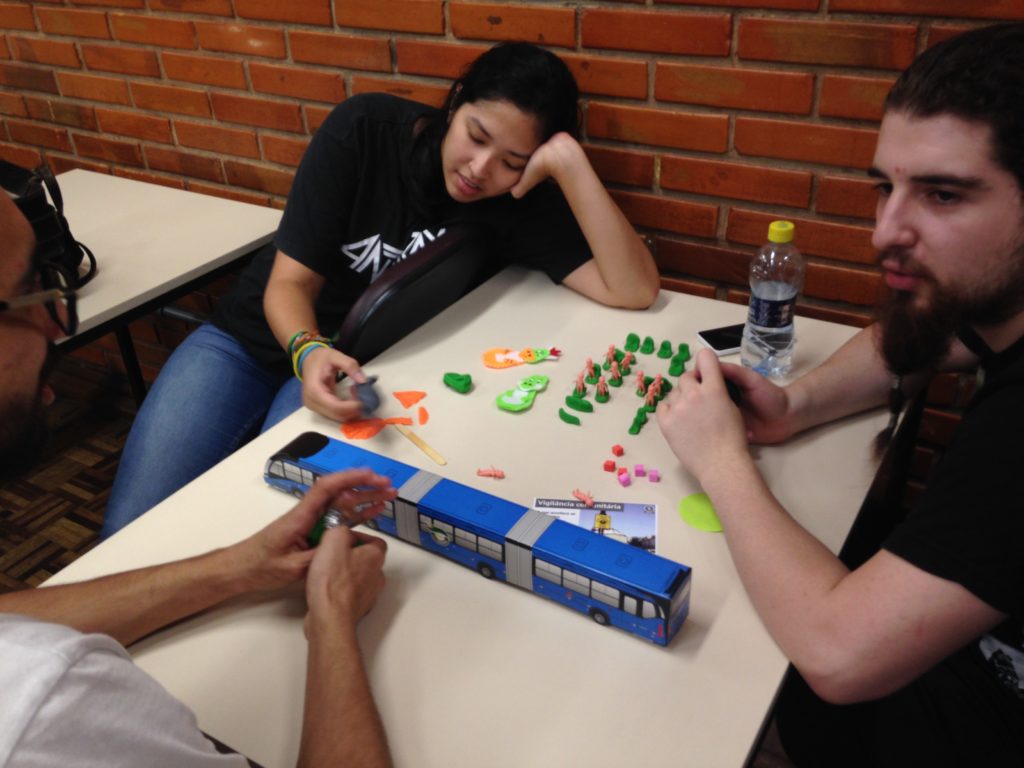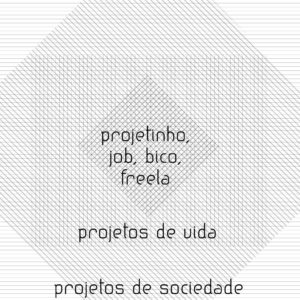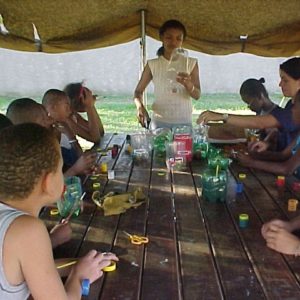Regular course – 80 hs – Digital Design Bachelor – Catholic University of Paraná (PUCPR) – Taught together with Rodrigo Gonzatto
This course develops students’ creative and critical skills related to technology and society. Since the Digital Design Bachelor has already separate courses on Usability, Information Architecture, Ergonomics, and Interface Design, the Interaction Design course focuses on what is particular from this discipline: designing social interactions.
The course unfolded as a critical appropriation of foreign technologies and design methods. We relied on the Brazilian tradition of anthropophagy, emphasizing the cultural and collective process of devouring and digesting foreign ideas to create something uniquely local. The hybridization process involved five steps: admiration, devouring, digestion, absorption, and celebration. Central to this approach are bodily practices and simulations that shift the focus from interfaces to interactions, highlighting technology’s role in mediating human interactions and emphasizing the importance of contextually relevant design.
The interaction design theater and improvised videos have proven to be the most effective embodied exercises to raise awareness of oppression and encourage proactive responses. The approach promotes transformative learning, enabling students to evolve by incorporating the Other into their Self and becoming critically conscious designers capable of responding to local needs and challenges.




Syllabus for the last cohort (2018)
This course had several cohorts. The Anthropophagic Studio article describes its pedagogical evolution. This is the last iteration in which Frederick and Rodrigo taught together.
| COURSE NAME: Interaction Design |
| TEACHERS: Frederick van Amstel and Rodrigo Gonzatto |
| REQUIREMENTS: None |
| SEMESTER: 6th |
| SUMMARY: Fundamentals of Interaction Design and interactivity design. Historical review of Interaction Design and its intersection with other disciplines. Social, cultural, and psychological aspects of interaction. Technology as mediation. Creation and adaptation of interactive products and systems. Prototyping and research with users in the development of artifacts. |
| COMPETENCES: 1. Understand the concept of interaction and the interdisciplinary approach to Interaction Design from a critical perspective; 2. Understanding Interaction Design from a historical perspective, as well as an awareness of the social, anthropological, environmental, and economic implications of its activity; 3. Mastering methodological aspects of the interaction project, solving problems with autonomy; 4. Work in teams applying interdisciplinary concepts in the search for complete and integrated solutions 5. Propose innovative solutions based on methods and techniques for creating, researching, and developing interactivity |
| STUDY TOPICS: |
| 1. Fundamentals of Interaction Design and main concepts |
| 2. History of Interaction Design and research trends in interactivity |
| 3. Methodological approaches: User-centered design, Participatory design, and Design Livre |
| 4. Design processes of interactive artifacts: linear, cyclic, and iterative development |
| 5. Methods and techniques for creation, research and evaluation: design, prototyping and documentation of the interaction |
| 6. Social media and Internet of Things |
| METHODOLOGY: Teacher activities: Explanation of key concepts, histories, and theoretical approaches. Promotion of critical analysis of interactive artifacts. Presentation of videos, books, and reference materials. Stimulating creative ideas. Projects mentoring. Student activities: Experimenting with hypermedia tools. Group discussion. Reading and reviewing texts and scientific articles. Class participation. Execution of practical exercises that allow the understanding of the study topics. Application of Interaction Design techniques and methods. Interaction Design project development |
| EVALUATION PROCEDURES: The final grade consists of the assessment based on the quality and participation of short and long interaction design projects. |
| BASIC BIBLIOGRAPHY: NORMAN, Donald A. The design of everyday life. Rio de Janeiro: Rocco, 2006. 271 p.• PREECE, Jennifer; ROGER, Yvone; SHARP, Helen. Interaction design: beyond human-computer interaction. Translation, Viviane Possamai. Porto Alegre: Artmed, 2005.• PRIMO, Alex. Computer-mediated interaction – Communication, cyberculture, cognition. 2nd edition. Porto Alegre: Editora Sulina, 2008. |
| COMPLEMENTARY BIBLIOGRAPHY: COOPER, Alan; REIMANN, Robert; CONIN, David. About face 3: the essentials of interaction design. Indiana: Wiley Publishing, 2007. (ref. 005,711 C776af)• RECUERO, Raquel. Social Networks on the Internet. Porto Alegre: Editora Sulina, 2009. Available at <http://www.redessociais.net/>• ROYO, Javier. Digital design. 1. ed. São Paulo: Rosari, 2008. 169 p• BUXTON, Bill. Sketching User Experiences: Getting the Design Right and the Right Design. Morgan Kaufmann Publishers Inc., San Francisco, CA, 2007.• MOGGRIDGE, Bill. Designing Interactions. MIT Press, 2007. |
| RESOURCES NEEDED : Studio classrooms. Projector. Collaborative materials. |
Course schedule
| CLASS | DATE | PROGRAM CONTENT |
| 1 | 7/31/2018 | Course introduction Reading and debate on the Teaching Plan Introduction to Interaction Design Boids simulation + Conditional drawing + Facebook game |
| 2 | 08/14/2018 | Interaction design and counter-projects Perceived affordances and affordances Design for Behavior, Design with Intent Counter-project exercise on the PUCPR campus |
| 3 | 8/21/2018 | Design, oppression and collective reaction Definition of historical oppression Dark patterns Critical design Anthropophagic design Discussion of mockumentaries made in past cohorts |
| 4 | 08/28/2018 | Oppressive and libertarian interaction design Discussing the teachers’ IHC 2017 article Embodied interaction Theater of the Oppressed applied to Interaction Design Reflection on Education in Digital Design For next class: bringing printed news about oppressive technologies |
| 5 | 09/04/2018 | Newspaper Theater about oppressive technologies Aesthetics of the Oppressed Exercises Forum Theater with quick scenes depicting the interactions described by the news For next class: Emotional Freezer probe |
| 6 | 9/11/2018 | Image Theater about the oppressions experienced by students Aesthetics of the Oppressed Exercises Mermaid’s Corner Game Team building For next class: interviewing someone who is also oppressed in the same way |
| 7 | 09/18/2018 | Interaction rehearsing Theater image + Theater Forum to experience reactions to oppression Creating liberating technologies |
| 8 | 09/25/2018 | Design Theater with liberating technologies Acting with technologies and acting as technologies Collaborative design Speculative design and design fiction Home task: designing a patent for the liberating technology |
| 9 | 10/02/2018 | Liberating technology patent presentation |
| 11 | 10/16/2018 | Reality Hacking Phenomenology of technology Invisible Theater Urban interventions |
| 12 | 10/23/2018 | Mockumentary scripting Stakeholder mapping Puppet theater Interaction storyboard |
| 13 | 10/30/2018 | Production of fictional images Photomontages Fake news Imaginary maps |
| 14 | 11/06/2018 | Review of early video captures |
| 15 | 11/13/2018 | Mockumentary editing |
| 16 | 11/20/2018 | PROJECT PRESENTATION (IN CLASS) Wrapping up the course |
| 18 | 11/27/2018 | Reflection on futures and evolutionary notes |
Student works
A group of students redesigned the history of the Brazilian sports scene as if Brazil was a major power in the classic videogame Pong. This was an analogy made to comment on the relationship between sports, national identity, and politics.
Selected student works are exhibited in the Futurologias Museum.
Publications
Van Amstel, Frederick M. C. and Gonzatto, Rodrigo Freese. (2022). Existential time and historicity in interaction design. Human-Computer Interaction, 37(1), pp.29-68. DOI: https://doi.org/10.1080/07370024.2021.1912607
Van Amstel, Frederick M.C and Gonzatto, Rodrigo Freese. (2020) The Anthropophagic Studio: Towards a Critical Pedagogy for Interaction Design. Digital Creativity, 31(4), p. 259-283. DOI: https://doi.org/10.1080/14626268.2020.1802295
Frederick M. C. van Amstel, Rodrigo Freese Gonzatto, and Gláucio H. M. Moro. (2018). Improvised Video as a Medium for Learning and Designing Interactions. In Proceedings of the 17th Brazilian Symposium on Human Factors in Computing Systems(IHC 2018), Raquel O. Prates, Heloisa Candello, André P. Freire, Isabela Gasparini, Marcelle Mota, and Bianchi Serique (Eds.). ACM, New York, NY, USA, Article 28, 11 pages. DOI: https://doi.org/10.1145/3274192.3274220
Rodrigo Freese Gonzatto and Frederick M. C. van Amstel. (2017). Designing oppressive and libertarian interactions with the conscious body. In Proceedings of the XVI Brazilian Symposium on Human Factors in Computing Systems(IHC 2017). ACM, New York, NY, USA, Article 22, 10 pages. DOI: https://doi.org/10.1145/3160504.3160542 – Oct 31, 2017

